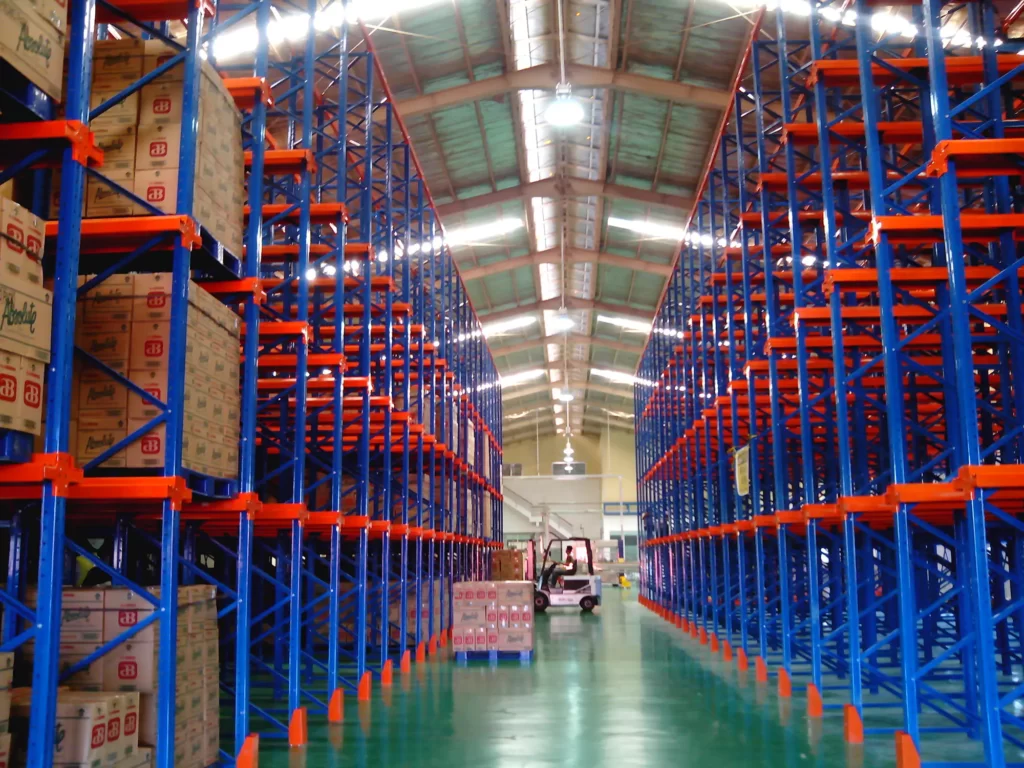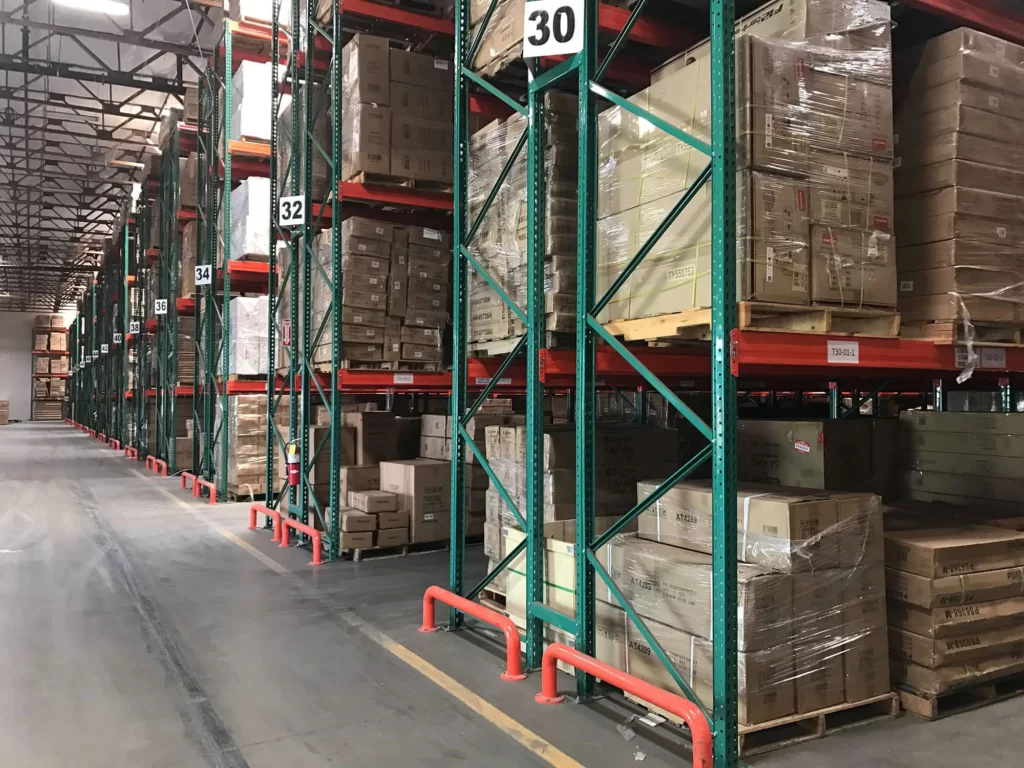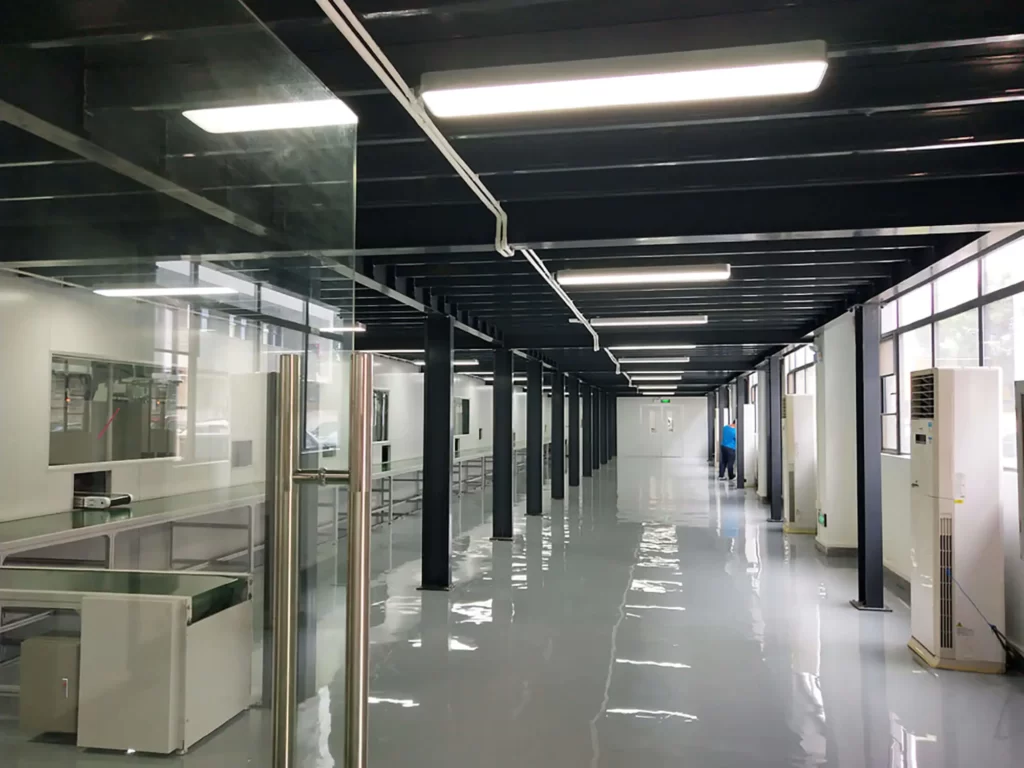With so many choices available, it is daunting to decide which palletized storage types are ideal for your warehouse. However, an unmindful selection should never be an option, as it is critical to optimizing your warehouse operations. That’s why this detailed post exists to help you make an educated selection.
This informative post will walk you through what palletized storage is and discuss its general benefits. Most importantly, you will explore the top 10 palletized storage types to enhance your inventory management by diving into their distinguishing characteristics and suitable use cases.
Whether you want to increase storage space, improve accessibility to your items, or boost order picking precision, you will find all the key information here, as well as tips to lay your hands on the palletized storage solution that meets your inventory requirements. Prepare to elevate your warehouse operations to the next level right away!
Getting To Know About Palletized Storage
In order to understand what palletized storage is, it is imperative to define a pallet. Despite its overwhelming popularity in warehouses, not everyone knows what this term is.
Pallets are flat wooden surfaces with a high load capacity that enable both horizontal and vertical stacking of merchandise, allowing for greater storage density by utilizing available vertical space.
Therefore, palletized storage is simply an inventory system that arranges goods on pallets to form a unified load that can be stored and transported along the supply chain. Typically, there are two primary arrangement methods that help improve load stability and prevent stock damage:
- Stacking method: This arrangement pattern means all items are stacked in the identical direction, ensuring complete homogeneity.
- Interlocking method: Unlike stacking, this technique requires piling items in an interlocked fashion, meaning the arrangements among layers are different from one another. This pattern helps increase the load stability of the pallet.
Equipamentos de manuseio de materiais like pallet jacks or forklifts is often used to ensure the smooth and efficient movement of palletized products throughout the warehouse and during transportation.
Significant Benefits Of Palletized Storage
Palletized storage is a game-changing development in the logistics business because of its many advantages. The following are some of the most attractive perks you can have when employing palletized storage for your warehouse:
- Augmenting productivity: By arranging products on pallets, palletized storage facilitates speedier goods handling, thus augmenting productivity. This benefit is especially useful for perishable commodities like fruits and vegetables, as they are time-sensitive.
- Streamlining operations: With palletized storage, loading and unloading of products can be streamlined by using appropriate handling equipment. Moreover, certain palletized storage types are semi-automated or automated, enabling more effective and accurate warehouse operations.
- Increasing throughput: Warehouse staff can stack pallets on top of one another and deliver them to the loading docks altogether, thus reducing the number of trips required. In other words, this means products can be ready for delivery more rapidly, thereby increasing throughput.
- Optimizing inventory space: This benefit is fairly straightforward. Compared to putting items on the warehouse floor, arranging them on pallets allows for more products to be housed in the same area. Not to mention, pallets are stackable, meaning they can make the most of your vertical space.
- Lowering risks: Palletized storage reduces the danger of stock damage and loss, particularly heavy items, while also offering enhanced safety for warehouse personnel and equipment. Thanks to pallets’ strong and flat surfaces, businesses can rest assured that their products are always safe when palletized.
In-Depth Analysis Of The Top 10 Palletized Storage Types
Palletized storage is definitely the go-to solution for most warehouses due to its wonderful benefits above. However, the tough question is which type you should employ for your warehouse. Before answering that, let’s begin by exploring the top 10 most popular palletized storage types below.
#1: Selective Palletized Storage
Also known as a static inventory solution, selective palletized storage is the most often used system in warehouses. Its appeal stems from the affordable cost and flexibility in customization, due to its extensive range of beam widths and upright heights.
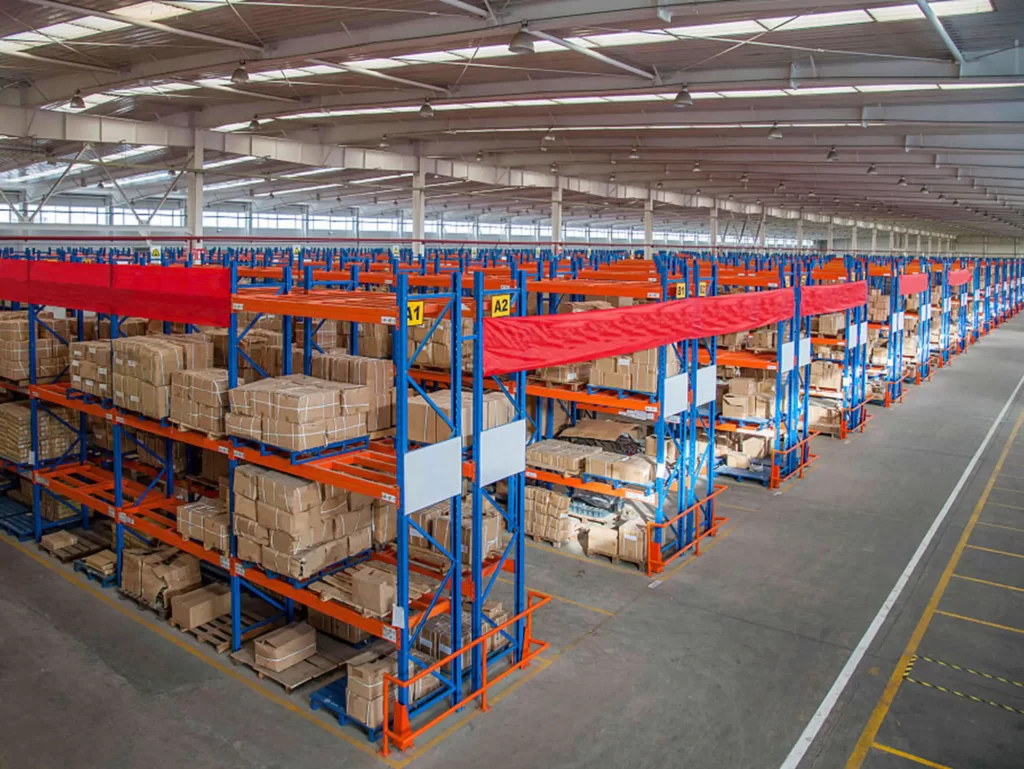
This palletized storage type not only enables you to hold products at different heights, but it also offers full access to them. That’s why people call it the “selective” type. Since its debut in the 1950s, selective palletized storage has undergone many developments, with the emergence of numerous subtypes, such as:
- Adjustable palletized storage: This is the most basic form of selective racks. Pallets on this system are handled by forklifts running parallel to the racking rows. While requiring a large surface area, adjustable palletized storage provides high flexibility and direct access to all stored products.
- Very Narrow Aisle (VNA) palletized storage: This subtype is an adaptation of the adjustable palletized storage, whose aisles’ width is lowered to minimize the amount of floor space required for the installation, yet direct access to all pallets is maintained. However, it requires special forklifts to function in the facility.
- Double-deep palletized storage: Unlike the VNA solution, estantes de profundidade dupla systems focus more on increasing storage capacity. By adding an additional pallet position at the rear of the racking, this palletized storage type can store products at two depths. But the drawback is a loss of direct access to every item.
Prós:
- Allowing individual pallet access for efficient picking and inventory management.
- Offering high space utilization by optimizing the use of available floor space.
- Improving visibility and control over stored inventory.
- Relatively simple to implement.
Com:
- Lower storage density and requiring more labor for pallet retrieval.
#2: Drive-In Palletized Storage
If you want to hold a large number of items in a compact space to achieve highly dense storage, drive-in system is your solution. By providing a single common entrance and exit point, this affordable palletized storage eliminates aisles and is thus ideal for inventory facilities with limited square footage.
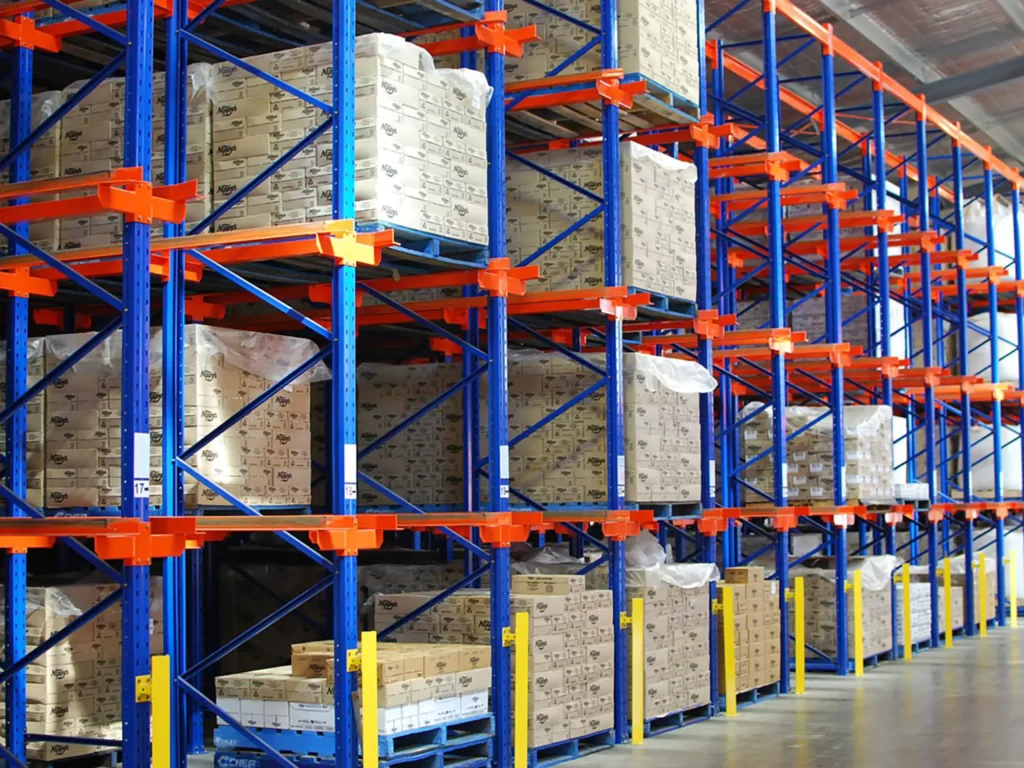
As the name suggests, the warehouse operator will drive the forklift into the system to place or retrieve pallets, but from one end only. While this setup is space-saving and good for LIFO inventory, it reduces accessibility to the innermost pallets and increases the risk of pallets and forklifts colliding.
Prós:
- Achieving high storage density by utilizing the depth of the racking.
- Having lower initial costs.
- Ideal for LIFO goods flow.
Contras:
- Limiting access to inner pallets, as only the front one is directly accessible.
- Lowering warehouse safety.
#3: Drive-Thru Palletized Storage
This next inventory system also provides high storage density, where pallets are stored multiple deep. However, unlike the drive-in solution, which only allows access from one side, drive-thru palletized storage is accessible from both ends of the racking structure.
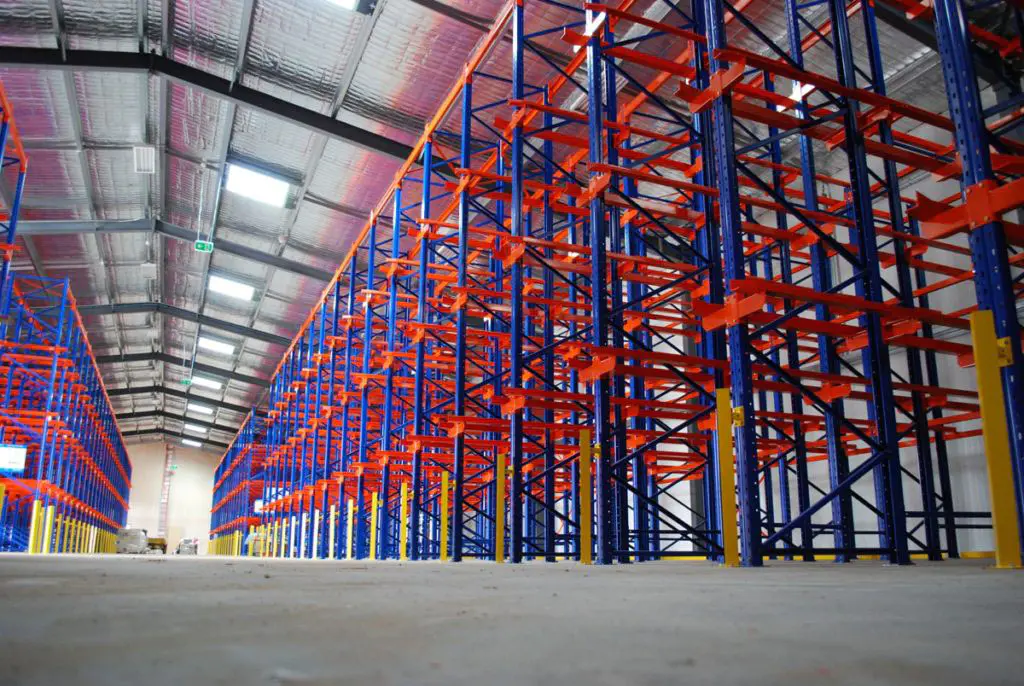
This smart configuration allows forklifts to enter one side, retrieve or deposit pallets, and then exit the other side, enabling FIFO inventory management. While the drive-thru system requires more aisle space compared to the drive-in solution, it provides better accessibility to all stored pallets.
Prós:
- Efficient use of available space with high storage density.
- Providing better accessibility to stored pallets compared to drive-in systems.
- Possibilitando FIFO gestão de inventário.
Com:
- Requiring more aisle space than drive-in systems.
#4: Push-Back Palletized Storage
In this configuration, pallets are stored up to six deep on inclined rails or carts that allow them to be pushed back as new pallets are added. When the front pallet is removed, the remaining pallets behind it roll forward on the angled rails, allowing easy access to the next pallet in the sequence. Thus, this work facilitates LIFO inventory management.

While this high-density storage can significantly increase the storage volume compared to selective racks and have lower upfront costs than other soluções de armazenamento like drive-in or drive-thru systems, it lowers accessibility to the inner pallets and is incompatible with operations requiring FIFO product movement.
Prós:
- Providing high storage density.
- Available at lower costs.
- Ideal for LIFO inventory management.
Com:
- Low pallet accessibility.
#5: High-Rise Palletized Storage
This palletized storage system typically features very tall racking structures, often reaching heights exceeding 12 meters. The key advantage of this approach is the significant increase in storage density. By capitalizing on the available vertical space, high-rise systems can store more inventory within the same footprint.
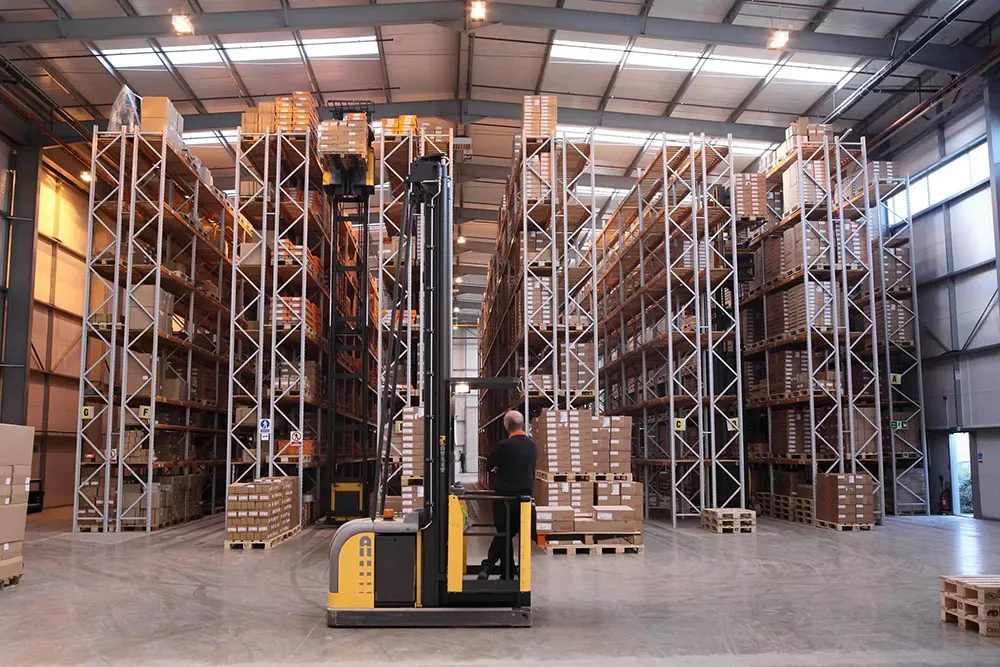
Technology integrations can further enhance this system’s capabilities. High-rise palletized storage often incorporates automated storage and retrieval mechanisms, like cranes or robotic shuttles. This automation not only increases productivity but also reduces the reliance on manual labor, leading to reduced operating costs over time.
However, the significant upfront investment required for high-rise systems is a key consideration, as the initial capital expenditure can be substantially higher than other palletized storage solutions.
Prós:
- Maximizing vertical space utilization, allowing for significantly higher storage capacity within the same footprint.
- Reducing reliance on manual labor, thereby lowering operating costs.
- Automated storage and retrieval mechanisms improve productivity and precision.
Com:
- Requiring a substantial upfront investment.
#6: Multi-Tier Palletized Storage
Multi-tier palletized storage is an excellent option for maximizing your warehouse’s vertical capacity while maintaining direct access to all the stored products inside. Unlike the tall structures of high-rise palletized solutions, this system comprises many levels of pallet racks, accessed by walkways or stairs.
This inventory approach allows your staff to reach all items directly, either manually by stairs or automatically by forklifts. Multi-tier systems are perfect for warehouses with little floor space but hold a large number of small goods, such as car parts and pharmaceuticals.
Additionally, this palletized storage type also provides great versatility in warehouse structure and operations. Its modular architecture enables bespoke configurations that can be adapted to individual product requirements, operating demands, and inventory flows.
Still, its complicated design and operating difficulties require meticulous planning and execution to assure peak warehouse performance and safety.
Prós:
- Optimizing warehouse’s vertical space, enabling better storage capacity.
- Maintaining direct accessibility to all SKUs, both manually and automatically.
- Facilitating a safer working environment for warehouse staff.
- Providing customizable layout options to meet various inventory needs.
Com:
- Requiring intricate planning to achieve optimal storage performance.
#7: Mobile Palletized Storage
Comprising racks placed on carriages that can move laterally, mobile palletized storage type reduces wasted aisle space, thus allowing you to hold more products. Therefore, this inventory solution works ideally for facilities with limited space or those that want to enhance storage capacity without horizontal expansion.

One of the most significant benefits of these mobile systems is their ability to offer high-density storage while keeping each shelf easily accessible. Hence, they are the perfect solution for holding rarely-used objects yet must be easily retrieved.
Furthermore, these systems provide increased security since the aisles can be shut to prevent unwanted entries. That said, mobile solutions can limit your direct accessibility to all pallets and require a level surface and enough room for carriages to operate. So, correct slotting and goods allocation are critical for their effective deployment.
Prós:
- Maximizing storage capacity via the reduction of wasted aisle space.
- Working well with compact warehouses that don’t want to expand horizontally.
- Augmenting warehouse security as the system can prevent unauthorized entry.
Com:
- Demanding a sizable level surface to work effectively.
#8: Live Palletized Storage
Like drive-thru solutions, live palletized storage works well with the FIFO system to allow for continuous product replenishment and space utilization. It encompasses a compact construction with lines of inclined roller beds on each level, enabling pallets to glide smoothly from one end of the system to the other.
Here is how this storage system works. New pallets always enter the structure’s higher side and travel to the other end thanks to the gravity force from the roller beds. With the use of brakes and safety devices, these movements are completely safe. Pallets will halt when reaching the other end, either by the ramp stops or the final pallet placed.
When implementing this system, it’s important to consider its height carefully. Firstly, most live palletized storage solutions work with manual handling equipment, which limits its height. Secondly, a higher inclination can lead to a great loss of inventory space, thereby lowering warehouse capacity.
Prós:
- Guaranteeing FIFO inventory flow with continuous goods replenishment.
- Maintaining direct accessibility to front pallets.
- Minimizing the distance forklifts have to travel to handle products.
Com:
- Limiting storage capacity when the structure is too high.
#9: Shuttle-Based Palletized Storage
While mobile systems have racking modules that move, shuttle-based solutions include a remotely operated shuttle to help transport pallets to either end of the racking structure. Rail-guided carts or veículos guiados automatizados (AVGs) are two popular kinds of shuttles utilized in this system.
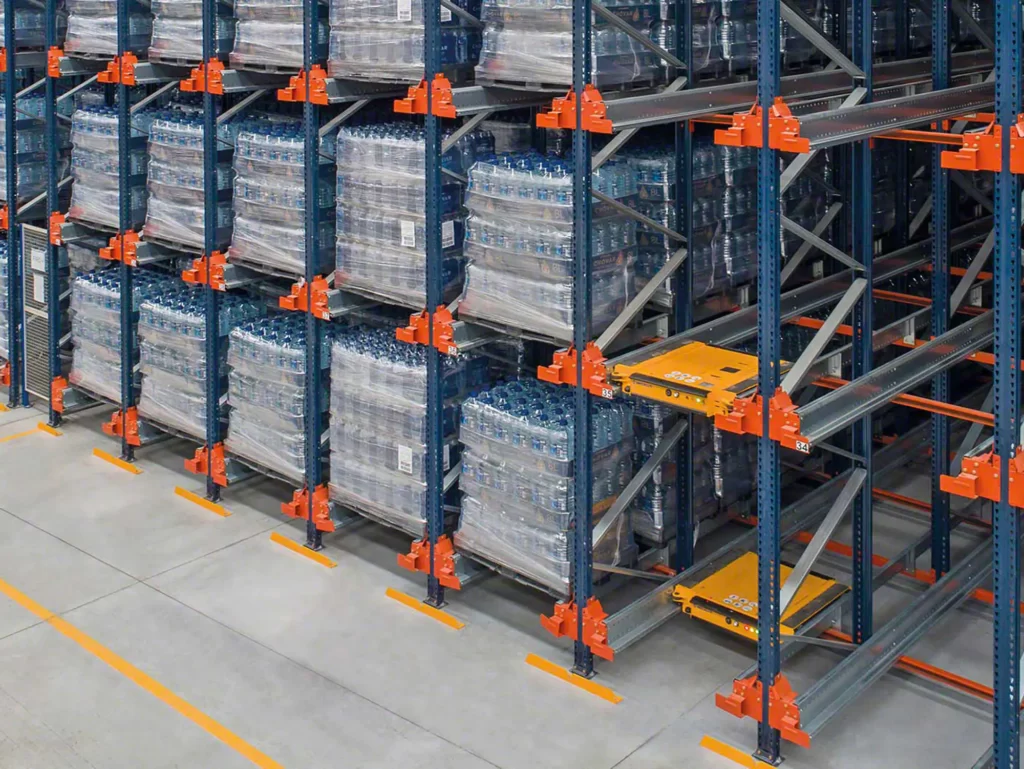
What sets this storage system apart is its automation capability, which saves time and costs, and the compatibility with both FIFO and LIFO inventory flows. It also provides maximum space savings, as each storage lane can reach up to 40-meter deep.
Still, one notable drawback is the system’s high upfront investment. Although the racking structure is reasonably priced, the electric shuttles are somewhat pricey. Thus, make sure to designate an appropriate budget before considering this storage option.
Prós:
- Significantly enhancing product cycles per hour.
- Offering up to 40-meter pallets deep.
- Automatically moving goods to the pick stations.
- Suitable for both LIFO and FIFO systems.
Com:
- Requiring a relatively large investment.
#10: Automated Storage And Retrieval System (ASRS)
Abreviado como AS/RS, this final palletized storage system is the warehouse expert that does the hard work of sorting, storing, and retrieving items on demand. This computer-controlled storage system not only provides real-time inventory checks but also optimizes both horizontal and vertical space for enhanced storage capacity.

Back then, AS/RS seemed to be an out-of-reach option for most warehouses due to its high costs. But today, as technology advances, the system’s expenditure is becoming relatively more affordable, making it the people’s favorite. Among its various types, unit-load AS/RS is probably the most popular one on the market.
Prós:
- Maximizing space utilization through high-density racking configurations and vertical space optimization.
- Improving accuracy and efficiency in storage and retrieval tasks.
- Providing enhanced inventory control, visibility, and management.
Contras:
- Requiring substantial upfront costs.
- Integration and implementation can be highly complex, requiring technical expertise.
Key Considerations When Choosing Palletized Storage
Now that you know the most prevalent palletized storage solutions, it’s time to learn how to make a well-informed choice. To do that, it’s critical to evaluate numerous elements that will impact your decision. These factors include:
Available Square Footage
Ao selecionar um palletized storage type, the first factor you must consider is the available inventory space in your warehouse. This input helps you determine the suitable pallet system as well as its scale.
Specifically, let’s consider your warehouse layout and vertical height, together with the floor load. Observing these aspects can facilitate the spotting of obstacles that may impede the installation of certain palletized storage solutions.
Accessibility Demands
The next consideration is how often you need to access your products. The good news for you is that almost every palletized storage solution offers fairly good direct access to stored items. However, as inventory demands are constantly evolving, some businesses may require higher accessibility.
If you demand fast and simple access to a large number of items, automated storage and retrieval systems (AS/RS) should be your go-to solution. In contrast, if you store items that are frequently used, bulk palletized storage alternatives will be more appropriate.
Características do Medicamento
In addition to accessibility, understanding your products is another must-do task in order to choose a suitable palletized storage system. Start off by considering your items’ dimensions, weight, fragility, and environmental demands, such as humidity and temperature.
Certain types of palletized storage are ideal for heavy materials, while others are better suited for miniature and lightweight items. Therefore, it’s critical to check the load capacity of your chosen storage system to guarantee it can accommodate your commodities.
Order Picking Speed
Another important factor to evaluate is the degree of order picking efficiency you want to accomplish. Fast and efficient order picking can lead to more orders being fulfilled accurately, thereby enhancing customer satisfaction and driving more revenues. Thus, never miss this step!
If speed is critical, consider inventory technologies that allow for quick and precise order picking, such as AS/RS. However, when accuracy is more needed, methods that emphasize smart arrangement and clear visibility, like selective palletized storage, are preferable.
Designated Budget
Don’t forget to assess your monetary limits when looking into palletized storage solutions. While some systems include additional functionality and facilitate automation, they can be more expensive. Thus, before making a selection, make sure to consider each option’s cost of ownership and long-term advantages.
Understanding this aspect and designating a specific amount for palletized storage solutions may save you days, weeks, or even months of planning and help you achieve much quicker results. By carefully evaluating this factor, you can reduce your alternatives and select the inventory system that meets your operating requirements.
Number Of Staff
Your ultimate choice of palletized storage solution also determines the number of staff needed for your warehouse. To identify the size of your labor force, you need to understand your targeted labor results.
For instance, if you want to cut labor costs by up to 50%, automation technologies like AS/RS are worth considering. However, if you utilize existing staff but want to increase productivity and throughput, you need to evaluate your present situation first to spot flawed processes. Then, rectify them with a suitable palletized storage choice.
Key Takeaways: All Palletized Storage Types In One Place
So far, this article has covered all the basics about palletized storage, especially the top 10 types of this concept. Yet, the vast amount of information can be overwhelming for some people. Thus, feel free to utilize the following summary table to learn about all palletized storage solutions in one place.
| Palletized Storage Systems | Vantagens | Desvantagens |
|---|---|---|
| #1: Selective Palletized Storage | Individual pallet access.Easy inventory management.High space utilization. | Lower storage density. |
| #2: Drive-In Palletized Storage | High storage density.Lower costs.Ideal for LIFO inventory management. | Limiting access to the innermost pallets.Lowering safety. |
| #3: Drive-Thru Palletized Storage | High storage density.Easy access to pallets.Suitable for FIFO inventory management. | Relatively higher expenses. |
| #4: Push-Back Palletized Storage | High storage density.Lower costs.Ideal for LIFO inventory management. | Low pallet accessibility. |
| #5: High-Rise Palletized Storage | Maximizing vertical space.High storage density.Automated item retrieval. | Custos iniciais mais altos. |
| #6: Multi-Tier Palletized Storage | Efficient use of warehouse space.Flexible layout.Automated item handling. | Complexity in design and operation. |
| #7: Mobile Palletized Storage | Optimizing storage capacity.Ideal for compact facilities.Preventing unwanted access. | Requiring level surfaces to work. |
| #8: Live Palletized Storage | Continuous stock replenishment.Maintaining direct access to front pallets.Reducing the forklift’s operating distance. | Too tall a structure can lower inventory capacity. |
| #9: Shuttle-Based Palletized Storage | High storage density.Increasing product cycles per hour.Ideal for both LIFO and FIFO approaches.Delivering goods to pickup stations automatically. | Higher initial investment. |
| #10: Automated Storage And Retrieval Storage (ASRS) | Maximizing space utilization.Improving accuracy.Enhancing inventory control. | Significant upfront costs.Complexity in implementation. |
Conclusão
Choosing the correct type of palletized storage is critical for improving warehouse operations and meeting business objectives. The right choice also helps you optimize storage space, increase accessibility, and boost order picking precision. Most importantly, it protects product integrity throughout all warehouse activities.
This article has provided you with a solid foundation for palletized storage, including its definition and numerous benefits. You also get to know different types of this storage solution, as well as important factors to consider when selecting one for your warehouse. Hopefully, the information will help you make the perfect choice!




